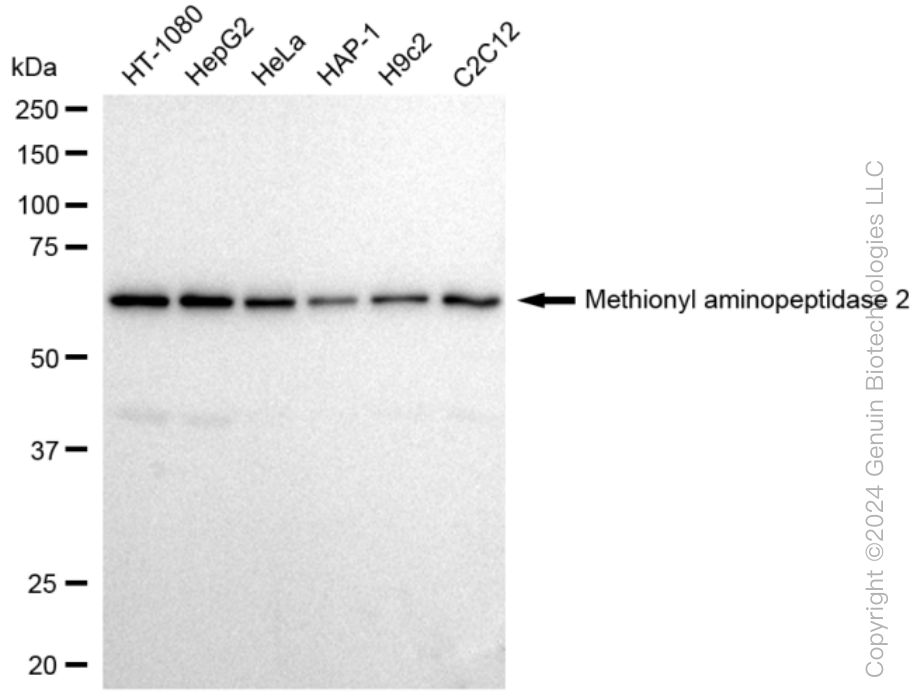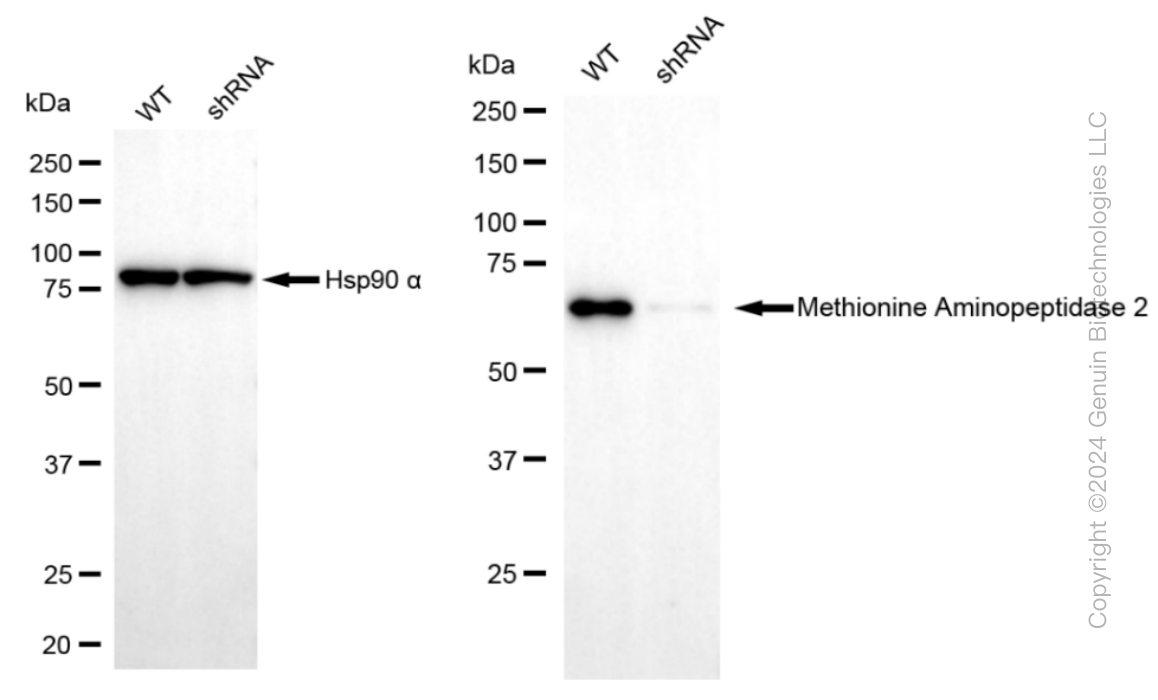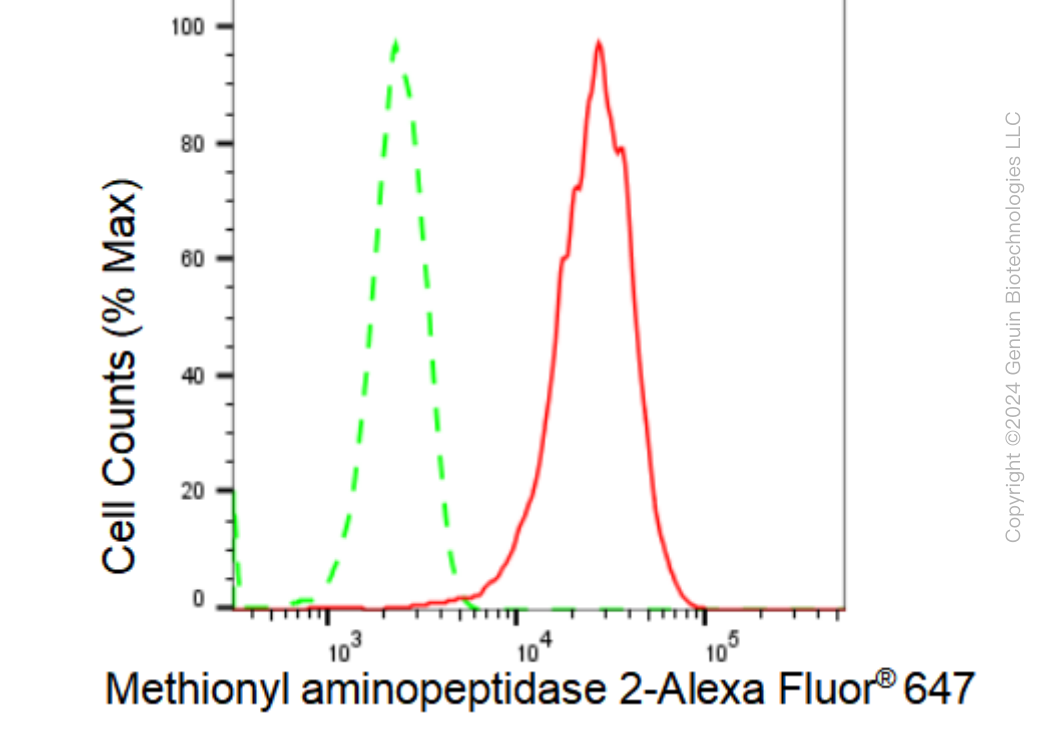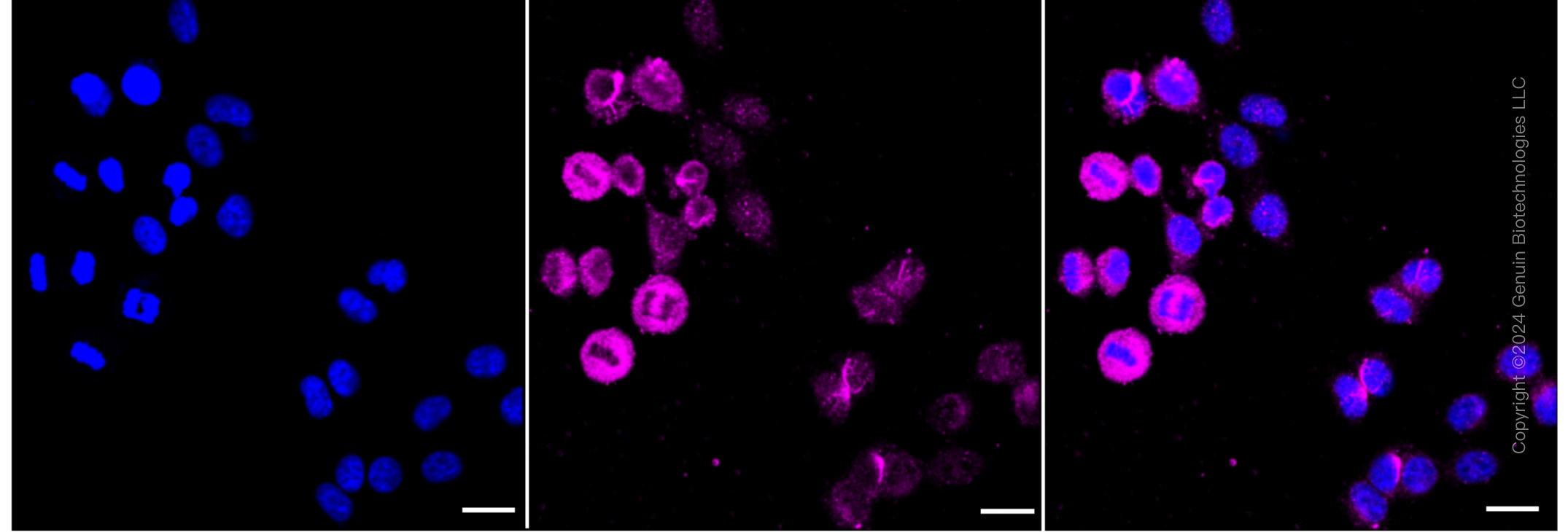KD-Validated Anti-Methionyl aminopeptidase 2 Rabbit Monoclonal Antibody
Rabbit monoclonal antibody
- SPECIFICATION
- CITATIONS
- PROTOCOLS
- BACKGROUND

Application
| WB, FC, ICC |
|---|---|
| Primary Accession | P50579 |
| Reactivity | Rat, Human, Mouse |
| Clonality | Monoclonal |
| Isotype | Rabbit IgG |
| Clone Names | 23GB 2565 |
| Calculated MW | Predicted, 53 kDa , observed, 67 kDa |
| Gene Name | METAP2 |
| Aliases | METAP2; Methionyl Aminopeptidase 2; MNPEP; MAP2; P67; Initiation Factor 2-Associated 67 KDa Glycoprotein; Methionine Aminopeptidase 2; Peptidase M; P67eIF2; Testicular Tissue Protein Li 17; EIF-2-Associated P67 Homolog; Peptidase M 2; EC 3.4.11.18; P67EIF2; MetAP 2; MAP 2 |
| Immunogen | A synthesized peptide derived from human Methionine Aminopeptidase 2 |
| Gene ID | 10988 |
|---|---|
| Other Names | Methionine aminopeptidase 2 {ECO:0000255|HAMAP-Rule:MF_03175}, MAP 2 {ECO:0000255|HAMAP-Rule:MF_03175}, MetAP 2 {ECO:0000255|HAMAP-Rule:MF_03175}, 3.4.11.18 {ECO:0000255|HAMAP-Rule:MF_03175}, Initiation factor 2-associated 67 kDa glycoprotein {ECO:0000255|HAMAP-Rule:MF_03175}, p67 {ECO:0000255|HAMAP-Rule:MF_03175}, p67eIF2 {ECO:0000255|HAMAP-Rule:MF_03175}, Peptidase M {ECO:0000255|HAMAP-Rule:MF_03175}, METAP2 {ECO:0000255|HAMAP-Rule:MF_03175}, MNPEP, P67EIF2 |
| Name | METAP2 {ECO:0000255|HAMAP-Rule:MF_03175} |
|---|---|
| Synonyms | MNPEP, P67EIF2 |
| Function | Cotranslationally removes the N-terminal methionine from nascent proteins. The N-terminal methionine is often cleaved when the second residue in the primary sequence is small and uncharged (Met- Ala-, Cys, Gly, Pro, Ser, Thr, or Val). The catalytic activity of human METAP2 toward Met-Val peptides is consistently two orders of magnitude higher than that of METAP1, suggesting that it is responsible for processing proteins containing N-terminal Met-Val and Met-Thr sequences in vivo. |
| Cellular Location | Cytoplasm {ECO:0000255|HAMAP-Rule:MF_03175, ECO:0000269|PubMed:21537465}. Note=About 30% of expressed METAP2 associates with polysomes |

Thousands of laboratories across the world have published research that depended on the performance of antibodies from Abcepta to advance their research. Check out links to articles that cite our products in major peer-reviewed journals, organized by research category.
info@abcepta.com, and receive a free "I Love Antibodies" mug.
Provided below are standard protocols that you may find useful for product applications.
If you have used an Abcepta product and would like to share how it has performed, please click on the "Submit Review" button and provide the requested information. Our staff will examine and post your review and contact you if needed.
If you have any additional inquiries please email technical services at tech@abcepta.com.














 Foundational characteristics of cancer include proliferation, angiogenesis, migration, evasion of apoptosis, and cellular immortality. Find key markers for these cellular processes and antibodies to detect them.
Foundational characteristics of cancer include proliferation, angiogenesis, migration, evasion of apoptosis, and cellular immortality. Find key markers for these cellular processes and antibodies to detect them. The SUMOplot™ Analysis Program predicts and scores sumoylation sites in your protein. SUMOylation is a post-translational modification involved in various cellular processes, such as nuclear-cytosolic transport, transcriptional regulation, apoptosis, protein stability, response to stress, and progression through the cell cycle.
The SUMOplot™ Analysis Program predicts and scores sumoylation sites in your protein. SUMOylation is a post-translational modification involved in various cellular processes, such as nuclear-cytosolic transport, transcriptional regulation, apoptosis, protein stability, response to stress, and progression through the cell cycle. The Autophagy Receptor Motif Plotter predicts and scores autophagy receptor binding sites in your protein. Identifying proteins connected to this pathway is critical to understanding the role of autophagy in physiological as well as pathological processes such as development, differentiation, neurodegenerative diseases, stress, infection, and cancer.
The Autophagy Receptor Motif Plotter predicts and scores autophagy receptor binding sites in your protein. Identifying proteins connected to this pathway is critical to understanding the role of autophagy in physiological as well as pathological processes such as development, differentiation, neurodegenerative diseases, stress, infection, and cancer.





